Steering you in the right direction
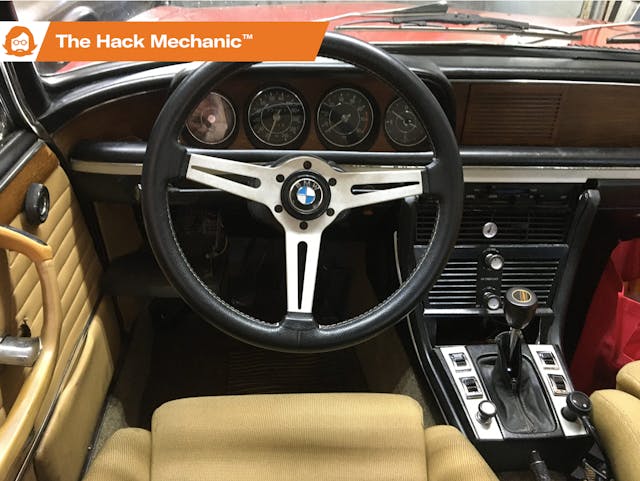
Today let’s talk about steering wheels. There’s no part of your car that you’re more in touch with. In addition to providing the literal hands-on input required to maneuver the car, the steering wheel is a crucial piece of interior decoration. It can seamlessly blend in period-correct fashion, or it can be an accent piece akin to a faucet in a designer kitchen.
Not unlike original radios that many of us, as 18-year-olds, threw into the garbage so we could slide in a stereo cassette deck and crank Dark Side of the Moon, many vintage steering wheels—particularly the large ones—were jettisoned in service of snappier-feeling steering. This is definitely the case in the vintage BMW world, where I spend so much time. Early 1970s 2002s, Bavarias, and 3.0CS E9 coupes had what are commonly referred to as “bus wheels” that are nearly 17 inches across. I’m as guilty as others of swapping them for smaller wheels back in the day, but as time has passed, I now recognize what an integral part of the interior look and feel of the interior they are. On a car like a 2002 that doesn’t have power steering, the big wheel makes it way easier to parallel park, a fact that I appreciate as I’ve gotten older and lost a certain amount of upper body strength. Plus, on a long highway drive, you can rest your hands on the bottom of the wheel.

If you do, however, want to replace a steering wheel, I thought I’d run through the basics.
In terms of mechanical connection, the wheel usually attaches to the steering column via a big nut and a lock washer. The top of the column is typically splined (slotted), so any replacement steering wheel must have the same spline pattern in its center hole. If the wheel has a circular horn button in the middle, just pry it up to reveal the nut. If the horn buttons are on the spokes and there’s a pad in the center instead, it usually pries up as well.

There also needs to be a mechanism to cancel the turn signal when the steering wheel is returned to center after a turn. This is usually done with a metal bracket that trips the little cancellation lever that protrudes from the directional stalk. If the bracket is a sleeve that slides over the top of the steering column, then swapping the steering wheel won’t affect it, but if instead the bracket is an integral part of the steering wheel, something will need to replace it or else the turn signals won’t cancel.
Electrically, steering wheels in vintage cars are trivial. Unlike in a modern car, they don’t have a “clock spring” needed to make the airbag, the radio volume and station buttons, and the cruise control work. All they have is a single connection for the horn. In order to make it so the horn wire doesn’t get wound up when you turn the wheel, vintage steering wheels typically have a little spring-loaded metal plunger on the back that makes electrical contact with the circular track on the top of the steering column.

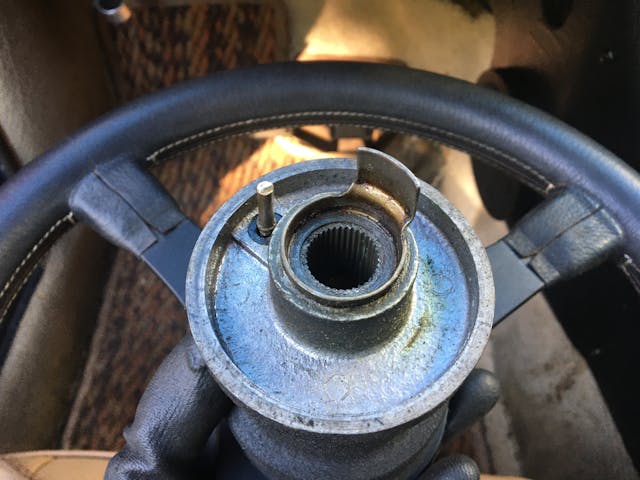
On some cars, though, the positions of these two components are reversed, with the circular contact track on the back of the steering wheel, and the spring-loaded plunger on the steering column.
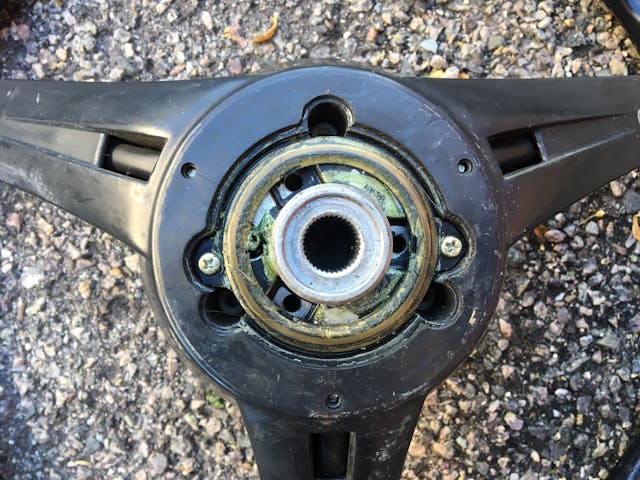
In either case, the way a horn typically works is that a relay—a remote electrical switch—is used, and pressing the horn button completes the electrical path of the low-current switch portion of the relay to ground, allowing it to pass through the plunger and the circular track and reach the grounded steering column, activating the relay and making the horn honk.
So, if you want to swap steering wheels, and if your car has the little spring-loaded plunger on the column, you need a wheel that has the circular contact track on the back. Conversely, if the contact track is on the column, you need a wheel with the plunger on the back. This particular bit of strangeness even strikes within a manufacturer family—the bus wheel in a BMW 2002 has the circular contact track on the steering column, but the nearly identical-looking bus wheels on the Bavaria and the 3.0CS E9 coupes have the contract track on the back of the wheel.
For all of the above reasons, the way that many aftermarket steering wheel manufacturers configure their wheels is that the wheel itself is universal and bolts to a hub that’s basically an adapter to the steering column, handling both the spline interface as well as the horn contact issue.


For example, if you have a vintage BMW and want to replace the big 16.5-inch bus wheel with a smaller, sportier Momo wheel, you could try to find a wheel you like that already has the correct hub on it, or you could select the exact wheel diameter you want, the rim thickness, the style of the spokes in the middle, and the finish of those spokes, and then buy a hub with either a circular horn contact ring or a plunger on it, made to adapt a Momo wheel and its standard 6×70-mm bolt pattern to your car. A quick online perusal shows that Momo hubs cost about a hundred dollars.

Lastly, I personally think it would be a sin against The Great Automotive Creator if you removed one of those beautiful early 1960s American steering wheels that is color-coded to the interior and has one of those gorgeous angular wing-like 120-degree horn rims and replaced it with a little chain steering wheel with a knob on it. But there’s no accounting for taste. And replacement steering wheels work best when they compliment a car’s interior as opposed to looking completely alien to it. For example, in my opinion, if a car doesn’t have a wood dash or other wood interior trim, then a wood steering wheel simply looks out of place.
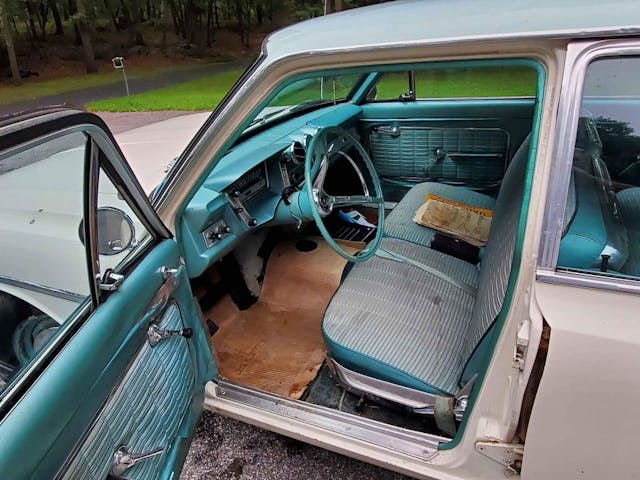
With all that said, I have to admit that what inspired me to write this is I just replaced the steering wheel in the ’73 BMW 3.0CSi E9 coupe I’ve owned for 36 years. The car has had a small (350mm) Momo-like vintage Fusina wheel for as long as I can remember, though I’m unclear how it wound up in the car. I’ve never really liked it. It seemed too small and too thick for the character of the car (it’s a touring car, not an autocross car), and its blackness was, well, boring. But I’d already replaced the original big flat seats with sporty Recaros, and the Fusina did kind of match their character. Yet when I happened into a used original E9 bus wheel and swapped it in, the size differential was so vast that I couldn’t get used to it.

But Carter, the 1976 BMW 2002 I bought last month, came with an interesting Momo steering wheel. At 380mm (15 inches), it was a good intermediate size, it was thinner than the Fusina wheel, and had brushed aluminum center spokes that matched nothing in the 2002 but I immediately thought they would complement the brushed aluminum trim that’s below the E9’s wood dashboard.
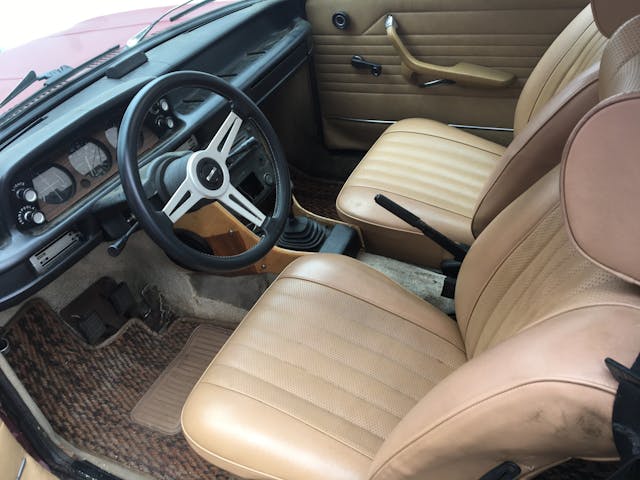
The problem was the horn ring issue—as I said, in the 2002, the horn contact ring is on the steering column, but in the E9 coupe, it needs to be on the steering wheel. At first, I thought I could swap the steering wheels on the hubs, but the bolt circles were different sizes. I could’ve ordered the correct Momo E9 hub, but by carefully drilling and tapping two holes, I found that I could transfer the circular contact ring from the Fusina’s hub to the Momo’s.
The moment I installed the wheel in the 3.0CSi, I saw that the brushed aluminum not only complemented the trim below the dash, but also the aluminum shift surround and the silver centers of the knobs. And as soon as I drove the car, I was won over by the new wheel’s slightly larger diameter and thinner grip. I love it.
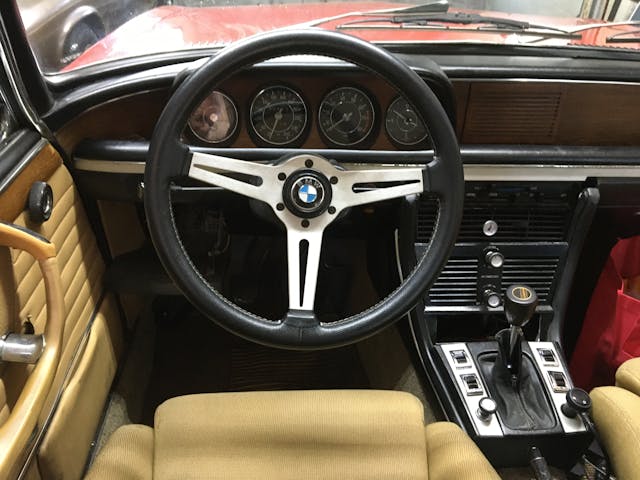
The neat thing about swapping steering wheels is that you can easily swap them back. They’re almost like shoes or sportscoats or hats. Which wheel do you feel like today? Just remember that, if the wheel has never been off the car, that nut and lock washer (and possibly Locktite as well) are going to be very tight. You might not be able to hold the wheel tightly enough to break the nut off, and relying on the steering column lock (if the car has one) can damage it. If you have an impact wrench, it’s a great way to zip the nut off without damaging anything.
So, if the urge grabs you, try grabbing a different steering wheel. Just be sure to put the old one on the shelf where you stashed the original radio. You do still have that, right?
***
Rob Siegel’s latest book, The Best of the Hack MechanicTM: 35 years of hacks, kluges, and assorted automotive mayhem, is available on Amazon. His other seven books are available here, or you can order personally inscribed copies through his website, www.robsiegel.com.

